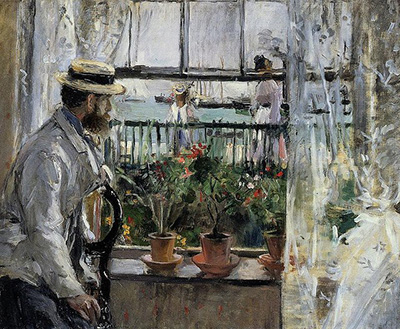The Morisot and Manet families would become close through their artistic association that occurred through the Louvre as well as a broader interest in the styles related to the Impressionist movement.
Berthe became particularly good friends with the brothers of one of the most famous impressionist artists, Edouard Manet. Gustave and Eugène, the latter who is displayed in this painting, shared many common interests with Berthe and also treated her with the upmost respect which wasn't always the case for women during this period in French society.
Berthe and Eugene would later marry in December 1874, giving this particular piece an even greater importance within her overall career. In fact, the scene is taken from their honeymoon which followed a year later. They had an extended break in Cowes, a town found in the very North of this small island that sits just to the south of the mainland. Her husband looks relaxed, enjoying the scenic view, presumably from their hotel room window. The detailed touches of the brush are limited, leaving a slightly abstract finish which is typical of most Morisot paintings. This artistic technique was relatively new at that time, but much more accepted within the norms of the art world today.
Two elegantly-dressed women walk past the window as he stares out. Several small boats lining the shoreline, whilst the couple's curtain's hang loosely, perhaps caught in a light coastal breeze. Three simple flower pots sit on the window sill, as the artist seeks to provide a cosy feeling to this hotel room, suggesting a happiness a their recent marriage and a delight to be in each other's company for this extended summer. During this period, the Isle of Wight was considered one of the go-to places within the UK for those with a high standing in society. Families would not go as far afield as many do today, and so trips like this were considered particularly luxurious, particularly when most could simply not afford any type of holiday at all.




